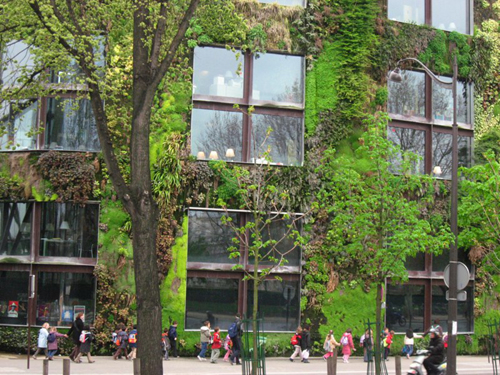“Growth is inevitable and desirable, but destruction of community character is not. The question is not whether your part of the world is going to change. The question is how.” ~ Edward T. McMahon
Quick, a pop quiz! What do the cities of Perth, San Francisco, London, Milwaukee, a-soon-to-be-rebuilt Detroit, Capetown, South Africa, and Houston have in common?
Anyone?
Anyone?!
If you happened to guess that each are rapidly changing urbanization as we know it, consider yourself virtually high-fived. Each of these cities is considered the first in adopting the notion that the cities in which we live need a bit more attention in the nature department. Defined, these cities are biophilic, or on their way to be. I realize that sounds a bit like a nasty rash that won’t go away and could potentially infect everyone around us, but thankfully, it is something much, much better.
Biophilic cities are the next wave of green goodness meant to reconnect city dwellers with nature, seamlessly. They are emerging across our big beautiful world with purpose: to create a setting in which residents are able to both see and experience nature in any given moment, throughout the normal course of our work and play.
It is more than a green initiative focused on the benefits of sustainable living that we inherently know and understand. Biophilic cities are intentional in design, intimately connecting our urban environments with our desire for exposure to nature in its purest form. What distinguishes a biophilic city from one that is green? Here is the short list:
There is an importance given to protecting and restoring nature within urban space, not removed from it.
Connections between local landscapes, history, culture and unique aspects of place are encouraged and cultivated constantly.
Every neighborhood is green, meaning each has ample access to nature, outside.
Within these cities there are diverse and multi-layered contact with nature, including smell, sound, and other sensory experiences.
Above all else, biophilic cities are based on the idea that the infrastructure and design shift in urbanization is completely pointless without continuing education about the benefits of exposure to nature on a regular basis.
So, where did this come from? Aside from a desire (and need) to green our lives up, there is more of a shift now toward the passion we all carry for all living things. Biophilia describes just that—the way we physically, mentally and emotionally need connection with nature and other forms of life in order to feel healthy and ultimately, fulfilled.
This emerging trend is more than community gardens and planting trees or flowers along busy thoroughfares—there is research that speaks strongly to the healing benefits that being outdoors can bring.
I remember the highlight of each day at my last job. It had little to do with conference calls or client meetings, but more the escape from the dingy walls and cold, dead environment I shared with my officemate. We would take ten minute breaks, outside, exiting the oppressive confines of our firm’s suite that sat in the center of one of two steel and concrete monstrosities, settled in the middle of a parking lot as big as the town in which I grew up.
Walking out the glass front doors, we’d turn right, making our rounds with purpose—soaking up as much sun or wind or cold fresh air we could in the ten minutes we were able to sneak away from our respective desks. There was no window in our office, and no natural light, and certainly no vegetation. We had a plant once—it didn’t last more than a few months. It couldn’t breathe; neither could we.
So we left the building. And although there was nothing grand to see outside our office walls, the air was enough to ground us.
But why?
Evidence shows that exposure to nature has exponential positive effects on our psyche—reduction of stress, recovery from illness, increased cognitive function (who doesn’t need that?), not to mention a greater desire to be kind.
Imagine being able to walk through a lush green path overflowing with vegetation, the sounds of birds chirping and the smell of fresh flowers overwhelming our nose… directly after an intense management meeting on a Monday morning. Biophilic design provides just that—a respite from the otherwise stressful lives we lead by simply getting back to our roots.
Through incorporating parks, walkways and gardens directly into building infrastructure, we are able to experience all the benefits of nature without giving up the perks of urbanization. Biophilic cities, then, are the perfect marriage of nature and livelihood as we know it.
Nature should not be an afterthought; rather, it should be viewed as the element that brings us all together. When we have a deeper connection with nature, our personal connections grow. Caring for the environment creates a greater desire to care for our fellow human beings. Connection breeds connection, and from there, meaning. Being a part of something that is bigger than ourselves sets in motion a greater understanding of this life experience. And it starts with what is just outside our doors.
So, how do we get involved? The Biophilic Cities project has an outstanding, informative web site that provides resources on how to get involved, as well as an easy link to join the network. Also, Tim Beatley, the author of Biophilic Cities, has a resourceful site that provides tons of information about how people just like us are getting involved in our own urban jungles.
The take away is this: the need for nature in our everyday lives is deeper than the economic and environmental benefits of going ‘green.’ Healthier and happier, simply because we are more connected not only to ourselves but to those around us—I can’t imagine a world where that isn’t worth a virtual high-five.
Love elephant and want to go steady?
Sign up for our (curated) daily and weekly newsletters!
Editor: Catherine Monkman
Photos: Matt Burlin/Tumblr












Read 1 comment and reply